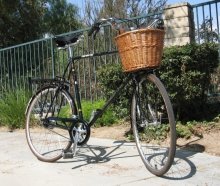(Some readers may recognize this from recent editing work I did on Wikipedia)
Wheel flop refers to steering behavior in which a bicycle or motorcycle tends to turn more than expected due to the front wheel "flopping" over when the handlebars are rotated. Wheel flop is caused by the lowering of the front end of a bicycle or motorcycle as the handlebars are rotated away from the "straight ahead" position. This lowering phenomenon occurs according to the following equation:
f = b sin ∂ cos ∂ *
Where:
f = "wheel flop factor," the distance that the center of the front wheel axle is lowered when the handlebars are rotated from the straight ahead position to a position 90 degrees away from straight ahead
b = trail
∂ = head angle
Because wheel flop involves the lowering of the front end of a bicycle or motorcycle, the force due to gravity will tend to cause handlebar rotation to continue with increasing rotational velocity and without additional rider input on the handlebars. Once the handlebars are turned, the rider needs to apply torque to the handlebars to bring them back to the straight ahead position and bring the front end of the bicycle or motorcycle back up to the original height. ** The rotational inertia of the front wheel will lessen the severity of the wheel flop effect because it results in opposing torque being required to initiate or accelerate changing the direction of the front wheel.
According to the equation listed above, increasing the trail and/or decreasing the head angle will increase the wheel flop factor on a bicycle or motorcycle, which will increase the torque required to bring the handlebars back to the straight ahead position and increase the vehicle's tendency to veer suddenly off the line of a curve. Also, increasing the weight born by the front wheel of the vehicle, either by increasing the mass of the vehicle, rider and cargo or by changing the weight ratio to shift the center of mass forward, will increase the severity of the wheel flop effect. Increasing the rotational inertia of the front wheel by increasing the speed of the vehicle and the rotational speed of the wheel will tend to counter the wheel flop effect.
A certain amount of wheel flop is generally considered to be desirable. Bicycle dynamics expert Jan Heine wrote, "A bike with too little wheel flop will be sluggish in its reactions to handlebar inputs. A bike with too much wheel flop will tend to veer off its line at low and moderate speeds." *
References:
* Heine, Jan. "Bicycle Quarterly -- Glossary". Vintage Bicycle Press. http://www.vintagebicyclepress.com/glossary.html.
** Foale, Tony (2002). "Motorcycle Handling and Chassis Design". Tony Foale Designs. p. 3-11. ISBN 8493328618. http://www.tonyfoale.com/book/
Friday, June 18, 2010
Wheel Flop, Defined
Subscribe to:
Post Comments (Atom)




No comments:
Post a Comment